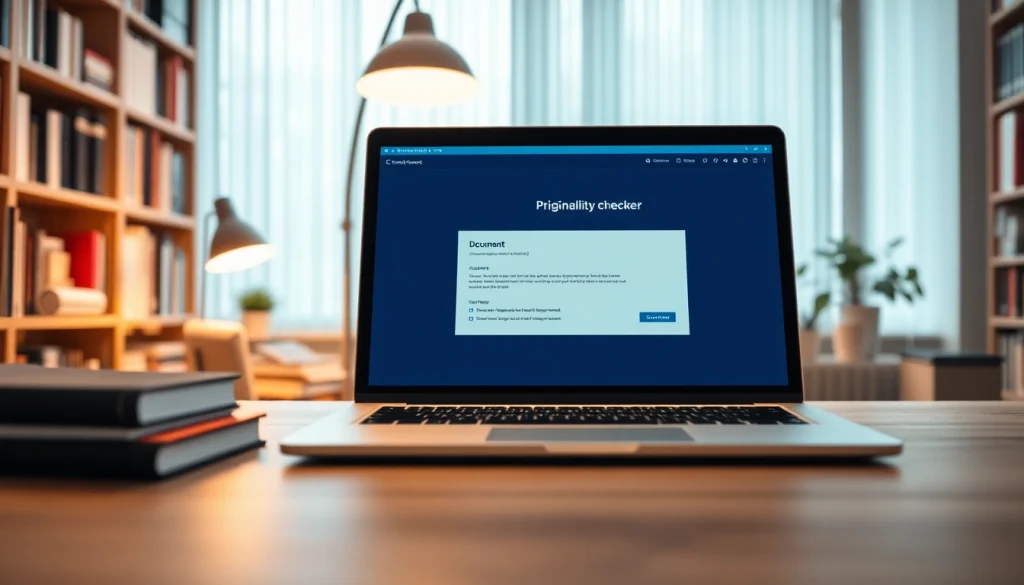Understanding Plagiarism Checkers
What is a Plagiarism Checker?
A plagiarism checker is a digital tool designed to detect instances of plagiarism in documents, essays, articles, and other forms of written content. This software compares the submitted material against a vast database of published works and online content to identify similarities or matches. By performing this analysis, plagiarism checkers help to ensure the originality of written content.
How Do Plagiarism Checkers Work?
Plagiarism checkers utilize complex algorithms and extensive databases to identify potential instances of copied text. The process typically involves the following steps:
- Text Submission: Users upload or copy-paste their content into the plagiarism checker.
- Database Comparison: The software scans the text and compares it against billions of web pages, articles, academic papers, and publications.
- Similarity Detection: If the software finds matching phrases or passages, it highlights them, showing the percentage of similarity.
- Report Generation: The user receives a report detailing which sections are plagiarized and links to the original sources.
Types of Plagiarism Checkers
There are several types of plagiarism checkers available today, catering to various needs:
- Free Online Tools: These basic tools provide a simple check for duplicates but often have limitations in terms of database size and features.
- Premium Software: Paid options usually offer more comprehensive checks, privacy protection, and a wider range of features, including grammar checks and writing assistance.
- Institutional Tools: Universities and educational institutions often use advanced platforms like Turnitin or SafeAssign, which compare submissions against their databases of previously submitted work.
- AI-Enhanced Checkers: Some modern tools leverage artificial intelligence and machine learning to provide deeper insights into writing patterns and paraphrasing.
The Importance of Using a Plagiarism Checker
Why Students and Professionals Need Plagiarism Checkers
Whether you’re a student working on a term paper, a researcher publishing academic articles, or a content creator writing blog posts, maintaining originality is crucial. Plagiarism checkers play an essential role in ensuring that your work meets ethical standards and avoids legal repercussions.
Consequences of Plagiarism
Failure to address plagiarism can lead to severe repercussions, including:
- Academic Penalties: Students could face failing grades, suspension, or expulsion.
- Loss of Reputation: Professionals may damage their credibility, leading to a loss of clients or job opportunities.
- Legal Issues: Copyright infringement can result in lawsuits and financial liability.
Benefits of Maintaining Originality
Using a plagiarism checker promotes originality and fosters a culture of respect for intellectual property. Furthermore, original content:
- Enhances Learning: Engaging with material meaningfully strengthens one’s understanding and analytical thinking.
- Builds Reputation: Original contributions establish credibility and authority in any field.
- Improves Engagement: Unique content tends to resonate better, attracting a loyal audience and building trust.
How to Choose the Right Plagiarism Checker
Key Features to Look For
Selecting an effective plagiarism checker involves careful consideration of several key features:
- Database Size: A larger database increases the likelihood that the checker will identify matches.
- Accuracy: Look for tools that provide reliable results with minimal false positives.
- User-Friendly Interface: A straightforward, intuitive design enhances the user experience.
- Custom Reports: The ability to generate detailed, easily interpretable reports is vital for understanding results.
- Support and Resources: Some tools offer additional resources for improving writing skills and avoiding plagiarism in the first place.
Cost vs. Performance: What to Consider
When evaluating options, consider the balance between cost and performance:
- Free Tools: While there are several free options available, they often lack in features and accuracy.
- Subscription-Based Services: These generally provide enhanced features and better support but require a financial commitment.
- Institutional Subscriptions: Many universities offer access to premium tools, saving students money while providing top-notch resources.
Comparing Different Plagiarism Checkers
To adequately compare various tools, create a checklist based on the following criteria:
- Features: List all features offered by each software option, such as citation checks, grammar analysis, or integration with other writing tools.
- User Feedback: Look for reviews and testimonials regarding the effectiveness and reliability of various checkers.
- Customer Support: Ensure that the tool you choose has accessible customer service for troubleshooting or inquiries.
- Trial Offers: Take advantage of trial versions to test usability and performance before committing to a subscription.
Using a Plagiarism Checker Effectively
Step-by-Step Guide to Scanning Your Work
To maximize the benefits of a plagiarism checker, follow this simple process:
- Prepare Your Document: Make sure your document is well-structured and free of errors.
- Input Your Content: Copy and paste or upload the document directly into the plagiarism checker.
- Run the Check: Initiate the scanning process and wait for the results; this usually takes a few seconds to several minutes, depending on the length of the document.
- Review Results Thoroughly: Examine the report for any highlighted sections and the sources from which they were drawn.
- Make Necessary Adjustments: Revise your content to eliminate any flagged areas or add proper citations.
Interpreting the Results from Your Plagiarism Checker
Understanding the results from your plagiarism checker is crucial for effective revision:
- Percentage of Plagiarism: Most checkers provide a score indicating how much of your content matches existing material.
- Highlighted Sections: Review all highlighted portions, even those below a certain percentage, as some could indicate unintentional copying.
- Source Links: Pay attention to the source links provided, as they indicate where the matched content exists.
Improving Your Writing Based on Feedback
Utilizing feedback from plagiarism checkers can significantly enhance your writing skills:
- Learning to Paraphrase: Feedback can help you identify areas where paraphrasing or original thought is necessary.
- Identifying Patterns: Consistent plagiarism in specific sections may point to a need for deeper engagement with material.
- Strengthening Citations: Results can highlight areas where proper citation is required to maintain academic integrity.
Future Trends in Plagiarism Detection Technology
AI and Machine Learning in Plagiarism Detection
The implementation of AI and machine learning is revolutionizing plagiarism detection:
- Predictive Analysis: These technologies can anticipate potential plagiarism issues based on writing patterns and styles.
- Contextual Understanding: Advanced algorithms are becoming better at understanding the context of text, improving the accuracy of plagiarism detection.
- Enhanced Paraphrase Detection: AI is now able to identify paraphrased content more effectively, which was previously a challenge for traditional tools.
Emerging Features in Modern Plagiarism Checkers
As technology advances, new features are being integrated into plagiarism checkers, enhancing their capabilities:
- Integration with Writing Tools: Many checkers are now part of comprehensive writing assistance platforms, providing users with a seamless experience.
- Multi-Language Support: Advanced tools are beginning to offer support for checking plagiarism in multiple languages.
- AI-Generated Content Detection: New tools specialize in identifying content generated by AI, distinguishing it from human-written text.
Predictions for the Future of Content Authenticity
As the landscape of writing and publishing continues to evolve, several predictions can be made regarding content authenticity:
- Increased Regulation: Institutions may implement stricter regulations to ensure content integrity and originality.
- More Accessible Technology: The tools for checking plagiarism will become more affordable and accessible to a broader audience, fostering a culture of originality.
- Continuous Advancements: Ongoing developments in AI and machine learning will further enhance detection capabilities and provide insights into writing quality.


